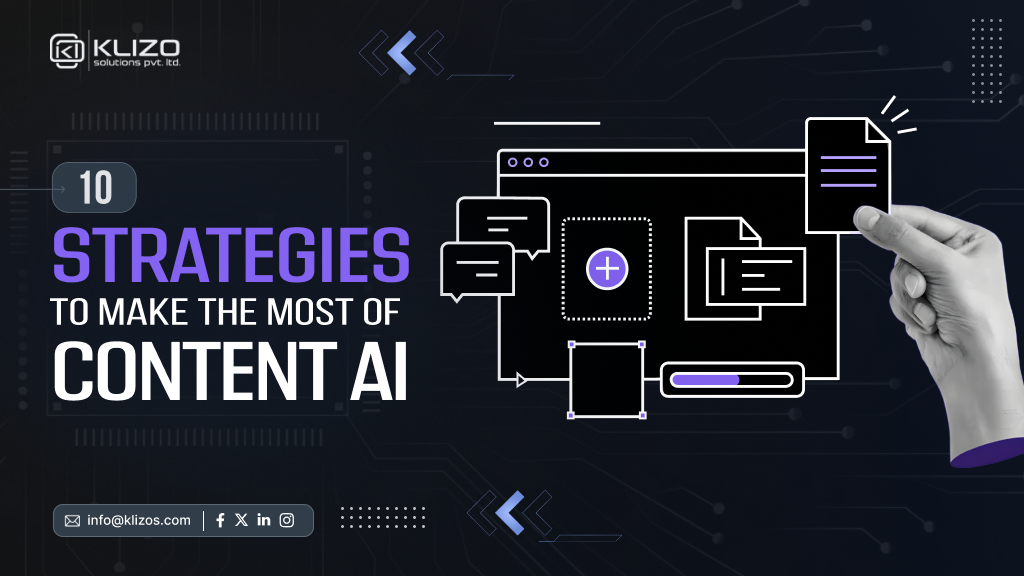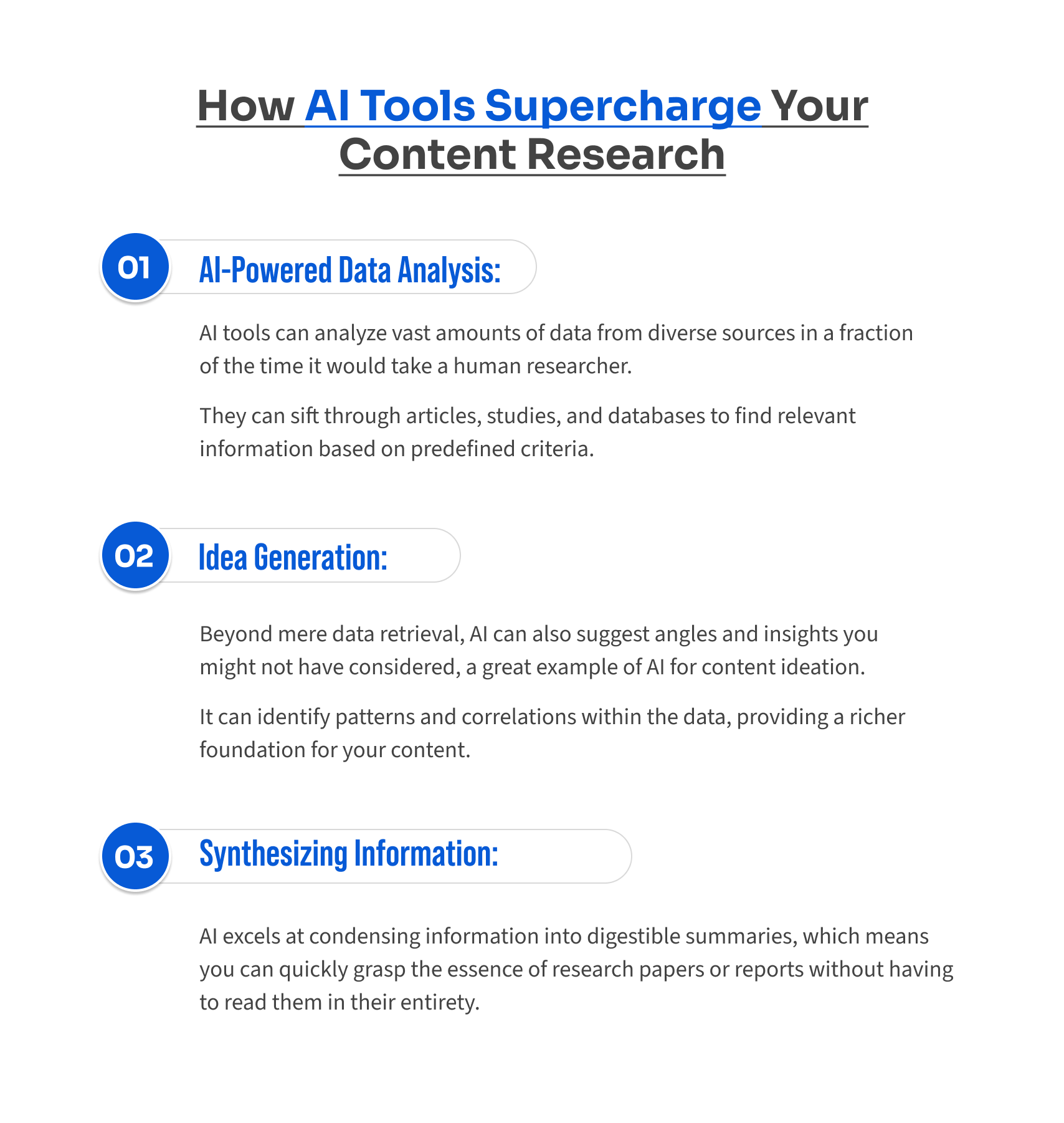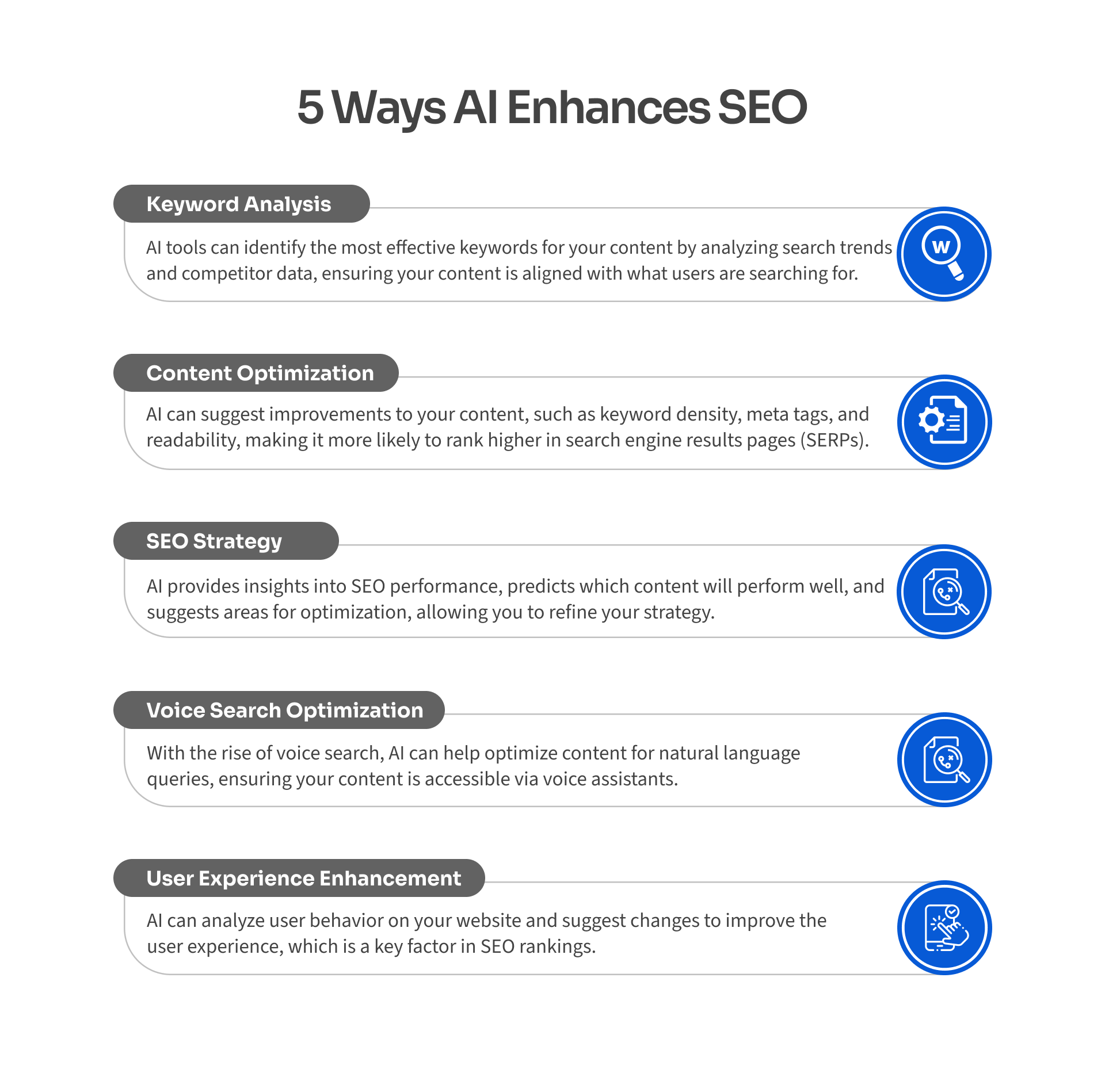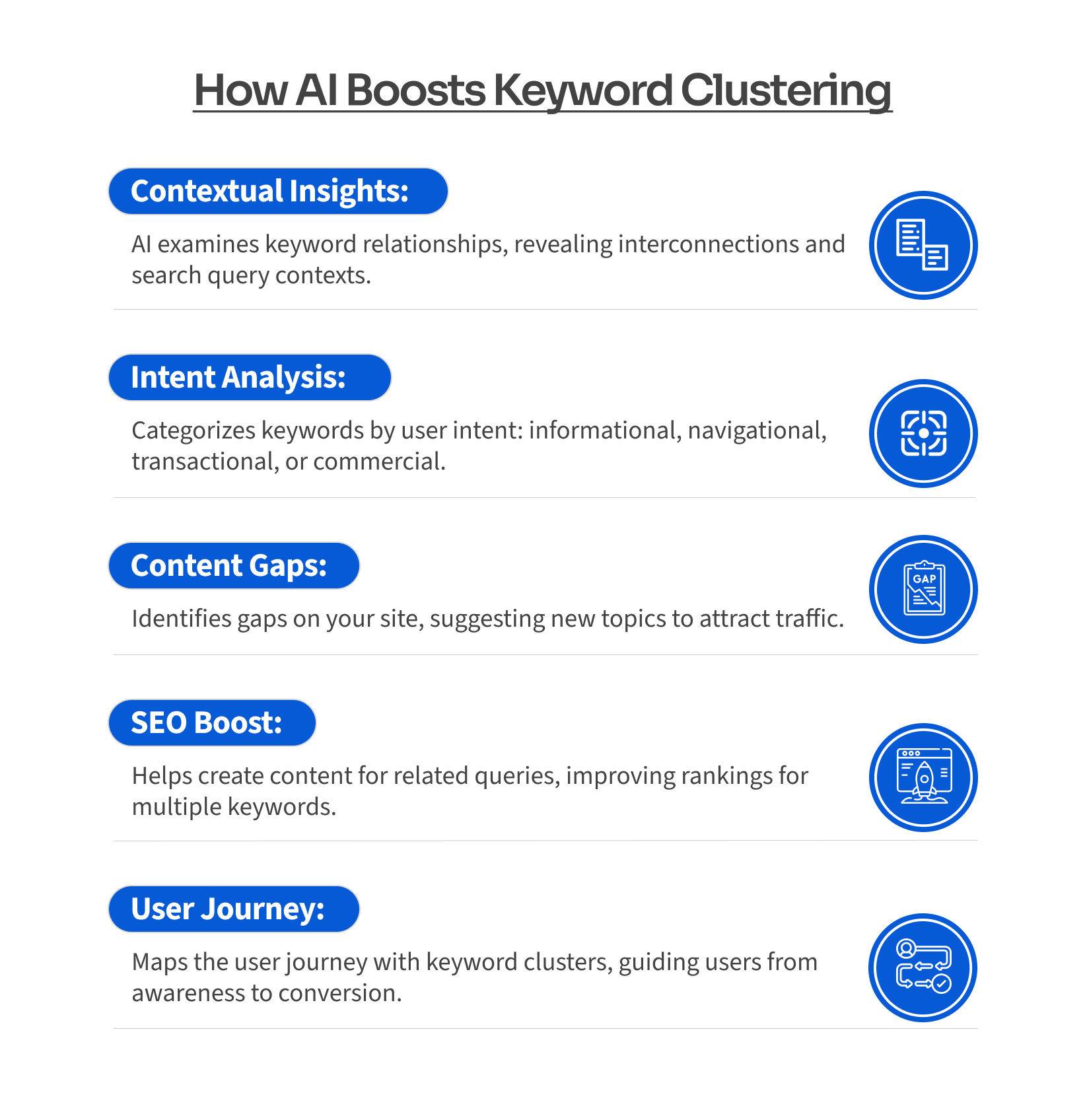


Content AI is the maestro of modernity at this time of the digital renaissance.
In a world where time is a precious commodity and efficiency is the name of the game, mastering the art of workflow optimization is key! And that’s exactly where content AI strategies, the not-so-secret weapon that savvy professionals are using to revolutionize their productivity.
Imagine a world where your workflow isn’t just a series of tasks but a symphony orchestrated by the harmonious blend of human creativity and artificial intelligence. This isn’t a futuristic fantasy; it’s the reality that content AI strategies bring to your digital doorstep.
So, buckle up as we embark on a journey to explore all the possible ways to seamlessly integrate Content AI into your content workflow and strategy, helping you work smarter, not harder!
Generating content outlines with AI is a strategic approach to organizing your thoughts and structuring your content before diving into the writing process.
There are various content AI strategies, and this one involves using AI tools to create a blueprint for your content, which outlines the main points, subtopics, and the logical flow of information.
You input your main topic or idea into the AI tool – It uses its learned patterns and data to suggest a structured outline – This outline typically includes an introduction, several main points or questions to address, and a conclusion – The AI’s suggestions are based on analyzing a vast array of related content and understanding what structure tends to engage readers and fulfill the content’s purpose.
Let’s say you’re writing an article about “The Impact of Remote Work on Global Productivity.” You would enter this topic into the AI tool, and it might generate an outline like this:

This AI-generated outline, as one of the content AI strategies, serves as a roadmap, ensuring that you cover all relevant aspects of the topic in a logical order. It also helps prevent writer’s block by breaking down the writing task into manageable sections, making the process more efficient and less daunting.
Speeding up content research with AI tools is another one of the content AI strategies. It’s akin to having a digital librarian at your disposal, one who not only knows where every piece of information is stored but also understands the context and relevance of that information to your needs.

Imagine you’re writing about the latest trends in renewable energy. An AI tool can scan scientific journals, news articles, and industry reports to compile a comprehensive overview of recent advancements, emerging technologies, and market forecasts.
It could also highlight key players in the field and summarize government policies affecting the industry. This not only speeds up the research phase but also ensures that you have a well-rounded understanding of the topic at hand.
By leveraging AI in this way of all the content AI strategies, you can significantly reduce the time spent on preliminary research, allowing you to focus on crafting a compelling narrative for your audience. The result is a more efficient workflow and content that is both informative and engaging.
Automating repetitive tasks with AI is another one of the content AI strategies where it’s like having a digital assistant dedicated to the mundane, yet essential, parts of your workflow. It allows you to reclaim time and mental space for the creative and strategic tasks that require your unique human touch.
Along with automated content generation, AI tools can be programmed to perform a variety of routine tasks that are typically time-consuming and prone to human error. These tasks may include:
Imagine running an online store flooded with hundreds of emails daily. With AI, you can automate sorting, sending order confirmations and tracking information, and flagging urgent customer complaints for immediate attention. It even organizes promotional inquiries separately for review later, which not only boosts response times but also frees you to focus on enhancing customer experience and growing your business.
By delegating these repetitive tasks to AI, you can concentrate on other aspects of your work, such as developing new ideas, strategizing for growth, and engaging with customers on a deeper level.

Personalizing content with AI involves using machine learning algorithms to tailor content to the preferences and behaviors of individual users. This personalization can significantly boost engagement rates by making content more relevant and appealing to each user.
For instance, a streaming service like Netflix uses AI to analyze viewing habits and then recommends shows and movies tailored to each user’s interests. This is a practical application of content AI strategies, enhancing satisfaction and loyalty.
By employing content AI strategies for content personalization, you can create a more engaging and satisfying experience for your users, encouraging longer and more frequent interactions with your business.
AI plays a crucial role in enhancing content SEO strategies by analyzing keywords and optimizing content for search engines, significantly boosting your content’s visibility and extending its reach to a broader audience.
Especially for digital marketers and content creators, leveraging content AI strategies to boost their content SEO is a game-changer!

Suppose you’re optimizing an article about “Sustainable Gardening Practices.” An AI tool can analyze related content and search queries to suggest the most relevant keywords, such as “eco-friendly gardening” or “water-saving landscaping.”
It can then guide you on where to place these keywords in your article, recommend meta descriptions, and even suggest internal linking strategies to other related content on your site. This not only improves the SEO of your article but also enhances the overall content strategy for better visibility and engagement.
By leveraging AI in these ways, you can ensure that your content is not only rich in quality but also primed for maximum online visibility, helping you reach a wider audience more effectively.
Enhancing audio and visual production with AI is about embracing the digital revolution in media creation. Just like for other content AI strategies, AI technologies offer a suite of tools that can significantly streamline the editing process, making it more efficient and less labor-intensive.
Imagine you’re producing a documentary with hours of footage. An AI tool can automatically sort through the clips, identifying and compiling the most relevant segments based on the themes you’ve set. It can balance audio levels, remove unwanted noise, and even suggest the best order for the scenes, which speeds up the post-production process and ensures a polished final product that resonates with viewers.
By leveraging AI in audio and visual production, creators can focus more on the creative aspects of storytelling and less on the technicalities of media editing. Similar to the other content AI strategies that we’ve discussed till now, the result of using AI for audio-visual production is not only a more efficient workflow but also a higher caliber of content that stands out in the digital landscape.
Predictive analytics powered by AI is a forward-looking approach that enables content creators to anticipate trends and user behavior.
By analyzing historical data, AI algorithms can identify patterns that are likely to recur, providing insights into what topics will become popular and how users will interact with content in the future, a key benefit of content AI strategies
Consider a blog focused on health and wellness. AI predictive analytics could analyze search query data and social media trends to predict an upsurge in interest in plant-based diets. The blog could then prepare articles, recipes, and tips related to plant-based eating ahead of the curve, ensuring the content meets the audience’s needs just as the topic peaks in popularity.
By utilizing content AI strategies like AI for predictive analytics, content creators can stay one step ahead, crafting content that not only meets current demands but also addresses emerging interests and questions, keeping the audience engaged and informed.
Utilizing AI to cluster keywords is another one of sophisticated content AI strategies that enhance content relevance and SEO performance.
By grouping keywords based on shared themes or user intent, AI can provide a deeper understanding of the context in which they are used, leading to more targeted and effective content strategies.

Suppose you’re developing a content strategy for a fitness blog. AI can cluster keywords around themes like “home workouts,” “nutrition tips,” and “fitness equipment.” It allows you to create comprehensive content that covers these themes holistically, addressing various related queries within each cluster. As a result, your blog becomes a one-stop resource for fitness enthusiasts, improving your site’s authority and search rankings.
Using this content AI strategy, you can craft a more nuanced and effective content strategy that resonates with your audience and performs well in search engines.
Content translation through AI is a transformative tool for global communication and one of the super useful content AI strategies, enabling you to reach a diverse audience by breaking language barriers.
Imagine an e-commerce platform expanding globally. Now AI, as one of the content AI strategies for content translation, can instantly translate product descriptions, reviews, and support material into various languages, ensuring all users have access to information in their native tongue.
Utilizing AI in this way, one of content AI best practices, not only broadens the platform’s reach but also builds trust with international customers, letting a business efficiently scale its content across linguistic boundaries, fostering inclusivity and expanding its global footprint.
Implementing AI tools for feedback and improvement transforms the way content creators refine their work. These content AI strategies analyze content performance, providing actionable insights and suggestions for enhancement.
For a blog post on healthy eating, an AI tool can track metrics like time spent on the page and bounce rate. It might suggest more engaging headlines or interactive elements like quizzes to increase user retention.
By acting on these AI-driven insights, one can enhance their work’s performance and relevance, and systematically upgrade their content, ensuring it resonates with their audience and achieves desired outcomes.
As we draw the curtains on our enlightening journey through the realm of content AI strategies, let’s pause and ponder the path we’ve traversed.
We’ve seen how AI can be the wind beneath the wings of the content creation and content strategizing process, propelling you towards horizons of heightened productivity.
But don’t forget that power lies not in the AI tools themselves but in how we wield them. It’s the human touch and the creative spark that ignites the potential of AI.
And this is where Klizo Solutions enters the stage, your choreographer in the art of content creation and materializing the best content AI strategies!
Our copywriting team is not just talented; they are maestros of the written word, blending the best methods with their boundless creativity to craft content strategies that resonate with your business’s unique voice.
With us, you’re not just getting content; you’re experiencing the confluence of strategy and creativity that elevates your brand’s story, engages your audience, and drives your business forward.
So, let us take the helm of your content strategy, employing content AI strategies with a human touch, to navigate through the digital seas towards the horizon of success. Together, we’ll ensure that your content is not only heard but also felt, leaving a lasting impression that echoes the excellence of your brand!
Joey Ricard
Klizo Solutions was founded by Joseph Ricard, a serial entrepreneur from America who has spent over ten years working in India, developing innovative tech solutions, building good teams, and admirable processes. And today, he has a team of over 50 super-talented people with him and various high-level technologies developed in multiple frameworks to his credit.

Subscribe to our newsletter to get the latest tech updates.